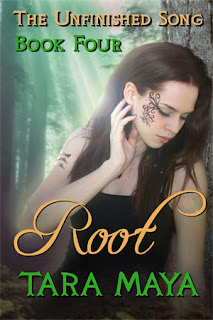- by Tara Maya
Analysis of a Book Cover
One more day…
With just ONE DAY LEFT to the release of Wing, I thought it would be fun to take a look at the book cover. What goes into the design of a book cover?
The first consideration is obvious: a cover should have aesthetic appeal. The image should caress the imagination, not assault the eyes. One mistake that some writers make, when they have control over their covers, is to want to stuff all the events of the book into the cover. Or they want to show a scene (not always a bad idea) with every detail exactly as it is in the book (always a bad idea).
For a lot of reasons, that’s not practical. Yes, sometimes the artist has time and a budget of thousands of dollars to hire models, make sketches, paint with oils, let the oils dry, die tragically young after lobbing off a few facial features, become famous after death, have his paintings posthumously sell for millions at auction, have other artists rip off his style in cheap knock-off paintings done in artistic slave factories in China, have one of those scanned into Photoshop, and finally (a crucial step) have all the heads in the scanned painting replaced with other heads, thus creating a unique picture which can be used as a book cover. But there’s not always time for that.
Instead, when you look at most covers, you’ll find they strive for a simple, striking design evocative of the mood of the book, portraying a main character, in a pretty dress. And it should follow the rule of thirds. You’ll notice that the sky and tress take up two thirds of the space; the human figure also takes up about a third of the space.
Wing is Book 5 in The Unfinished Song series, so it has to have some features in common with the previous books. The Unfinished Song is a twelve book series, but here’s a little secret–you can subdivide that into four parts, or four trilogies, each with their own story arc.
The first three covers all feature the heroine, Dindi, in her white Initiate garb, because the entire trilogy takes place over the year she is undergoing her tribe’s initiation into womanhood.
The first book shows Dindi against a mountainous background, because she travels from her clanhold in the mountains to a new place — Yellow Bear, where she will undergo the Test to see if she is worthy of becoming a Tavaedi. The little pixie shows that this is fantasy, and it will involve pixies…among other fae.
The second book cover shows the ocean, and a couple dragon-like faeries, because during this book. Dindi accompanies badass warrior Kavio on a peace mission to an enemy tribe, the Blue Waters, who live by the…wait for it… ocean. (They have a thing for sharks.)
On the third cover, we have a glimpse of the Stone Hedge where Dindi must confront the fae…among others. The winged figure in this picture is ambiguous, a little ominous… is it a faery? High Fae? Or Lady Death herself? This is also the first (and so far only) cover to show the corncob doll. The doll is show larger than described in the story, actually, because otherwise it would be almost impossible to see.
Root, Book 4, departs in some ways from the first three books. The actress is the same model (I’m not sure if you noticed) but she’s in a different outfit. Hm…doesn’t look too Neolithic in fabrication, but let’s hurry over that… The main point is that she’s no longer in white. She’s past her Initiation, and no longer quite so innocent. (Those aren’t tatoos on her face, by the way, but henna.) The green color scheme and forest background reflect the new lands the heroine is visiting. The black of her garment hints at a character who is not shown on the cover: Umbral, the Deathsworn who is hunting Dindi.
So now we come to the fifth book. Obviously, it’s important to preserve some of the same “look” as the series, while also hinting at the big conflict in the book — the fact that the heroine has been captured by her enemy, Umbral.
The unity of the series is maintained through the choice of fonts. It’s a good idea to never use more than three fonts on the same cover. Two is better. Here, and throughout the series, there are two. One for the title and another font for everything else. The exact position of the series name, book number, title and author name vary from cover to cover. Root and Wing, both part of the second trilogy, use a slightly larger font size for author name and title than the first trilogy.
Font choice is a standard feature for each book in the series. But obviously it’s important to make THIS book stand for itself too. Wing takes place over three moons, from the winter solstice to just before the spring equinox, and much of the time is spend on the slopes of mountains buried under winter. The dyed hair, black bindings, and faery dress all turn up in the book. The motif of wings also features strongly in the story. There’s no other reason for the blue and white color scheme, since the tribe they are approaching uses Orange magic. As I mentioned before, it’s more important to choose a color scheme that is visually compelling than one that reflects the events of the books literally.
Still…look for an orange-red color scheme in the next sequel, Blood.
Sometimes it’s also possible to throw in nice extras to the design. Did you notice the shape formed by the pattern of snowy trees behind Dindi?





